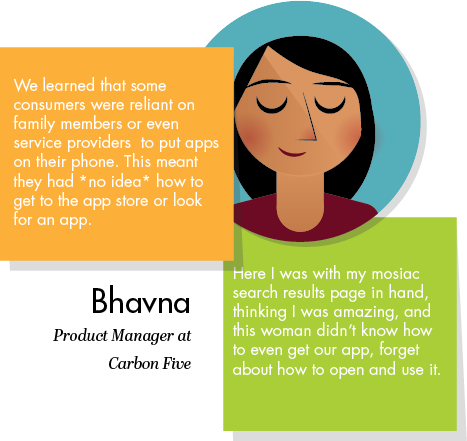The Carbon Five Guide to User Research: Introduction
What is User Research?
User Research focuses on understanding user behaviors, needs, and motivations through observation techniques, task analysis, and other feedback methodologies.
User research helps us understand the constraints and opportunities of the audience we’re building for, and is a core part of building a successful product.
Why Research?
Let’s say you’ve got a great idea for a product. Will your users agree? How do you reach them? In order for your product to succeed, it needs product/market fit.
Defining the users you want to reach and talking to them before you build will will give you empathy and a clearer sense what your users hope to achieve using your product. It’s much easier and more effective to design with a specific person fixed in mind than a set of demographics without a distinct voice.

When Research?
This guide covers qualitative research—research focused on interviewing a limited number of people in longer, more open-ended conversations in order to discover unknowns. This makes it well suited to open ended problems with a wide range of possible answers.
As great as it would be if you and your team conducted regular weekly user interviews, user research is a bit like pizza: any amount is good. But if you only can do it once, the best time to do it is at the beginning of a new feature set, a new product, or when you’re trying to adapt an existing product to a new market.

What You’ll Need
A quick note here: We’re discussing research the Carbon Five way (thus the title), but that shouldn’t dissuade you from doing research on your own terms with as much time and precision you can muster. You can talk to users and get excellent insights without following the full process, and we recommend that you do whatever you have time for. That said, if you want more in-depth help and training, come work with us! We offer a hands-on User Research Sprint. To do it yourself, here’s what you’ll need:
- Two or more people (it works best if the entire team is present, including developers)
- Two weeks (1-2 days to set up the research statement and script, 1-2 weeks part-time to recruit and schedule, and 2-3 days for interviewing)
- A laptop that can record audio or video
- Notebooks for anyone sitting in on interviews
- Lots of Post-it notes (or use an online tool like Stickies)
- A small budget for recruiting
What You’ll Do
(In the next few weeks we’ll be writing about each step of the process in more detail and linking to the next posts in the series as they go live.)
Write a research guide – Figure out what open questions you’re going to focus on and make a hypothesis about who your target user will be. Once you’ve written a research statement that defines what a successful outcome looks like, write the interview questions that will unlock how your product might fit into your user’s lives.
Recruit and schedule– Reach the people you need to talk to by getting scrappy and meet prospective users where they are, whether it’s from a recruitment ad on your existing website, through your personal social network, or through soliciting likely users off the street – whatever works! You’ll also write a screener to make sure your respondents match your target users.
Interview – The big day is here! Brush up on your interviewing skills and learn tips to get the most out of your conversation, bring a pair into each interview to supplement your notes and observations, and don’t forget to record the session.
Analyze – You and your team will sit down with all the information you’ve gathered and sort through the data looking for shared insights, shared trends, and user motivations and tasks to accomplish.
Define – Once you’ve untangled what your users want and need, you’ll start to generate solutions to their problems and turn them into a feature set for your product.
Prototype – It’s time to make the first version of your product! You’ll translate feature ideas into the flows that make up the core of your product’s user experience. (Then it’s time to start usability testing to make sure the features and solutions you defined actually meet the needs you’ve identified!)
After that…?
Build your product. Test it some more. Learn from your tests. Repeat. Create a culture of research.
Finally, if you want more hands-on coaching, we can help you learn from your users and turn the results into a product. Read more about our User Research Sprint.
Happy researching!
